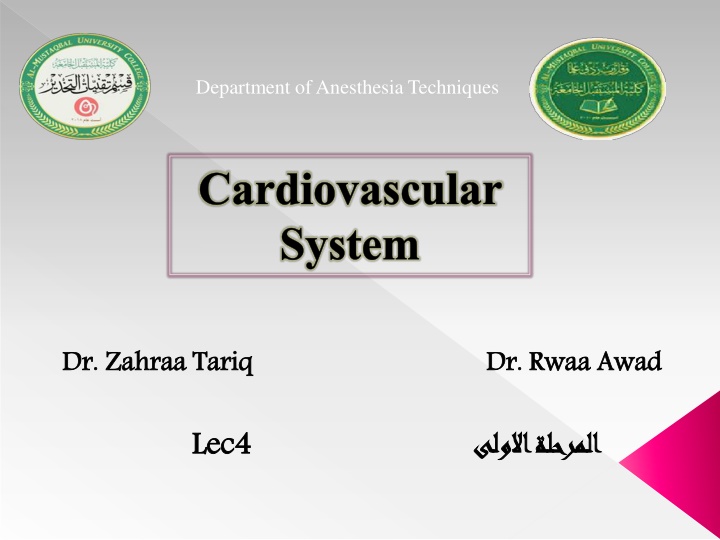
Cardiovascular System: Heart Structure and Circulations
The heart is a vital organ composed of four chambers, each with specific roles in the pulmonary and systemic circulations. The cardiovascular system includes the heart, its chambers, valves, and the circulatory pathways that transport oxygenated and deoxygenated blood throughout the body. Understanding the structure and function of the heart and its circulations is essential for grasping the complexities of the human body's cardiovascular system.
Download Presentation

Please find below an Image/Link to download the presentation.
The content on the website is provided AS IS for your information and personal use only. It may not be sold, licensed, or shared on other websites without obtaining consent from the author. If you encounter any issues during the download, it is possible that the publisher has removed the file from their server.
You are allowed to download the files provided on this website for personal or commercial use, subject to the condition that they are used lawfully. All files are the property of their respective owners.
The content on the website is provided AS IS for your information and personal use only. It may not be sold, licensed, or shared on other websites without obtaining consent from the author.
E N D
Presentation Transcript
Department of Anesthesia Techniques Cardiovascular System Dr. Dr. Zahraa Zahraa Tariq Tariq Dr. Dr. Rwaa Rwaa Awad Awad Lec Lec4 4
The Heart The heart is a muscular organ enclosed in a fibrous sac (the pericardium). The pericardial sac contains watery fluid that acts as a lubricant as the heart moves within the sac. The wall of the heart is composed of cardiac muscle cells, termed the myocardium. The inner surface of the wall is lined by a thin layer of endothelial cell called the endocardium.
The heart is consists of four chambers: Two atrium and two ventricles, separated by atrioventricular valve (AV valve). The left AV valve is called mitral valve while the right AV valve is tricuspid valve.
Pulmonary Circulations The right atrium collects blood loaded with CO2 from various body tissues as a result of tissue metabolism and pumped it into the pulmonary artery by the right ventricle. The pulmonary artery carry blood to the lungs, where gas exchange takes place between the lung capillaries and alveoli. As a result, oxygenated blood returns to the left atrium via the pulmonary veins. The pulmonary circulation is the blood flow from the right ventricle to the lungs and back to the left atrium.
Systemic Circulations Oxygen-rich blood in the left atrium enters the left ventricle and is pumped into a very large, elastic artery called the aorta. Arterial branches from the aorta supply oxygenated blood to all organ systems. As a result of cellular respiration the venous blood becomes low oxygenated and has a greater carbon dioxide content. The venous blood vessels drain into the superior and inferior venae cavae, which are two major veins that return oxygen-depleted blood to the right atrium. The flow of blood from the left ventricle to the entire body and back to the right atrium is known as the systemic circulation.
Pulmonary & Systemic Circulation
The Heart Valves The human heart contain four type of valves: Two atrioventricular valves(AV) between atria and ventricles: a) Tricuspid valves between right atrium and right ventricle. b) Mitral valve betweenleft atria and left ventricles. Two semilunar valves: a) Aortic valve between aorta and left ventricle. b) Pulmonary valve between pulmonary artery and right ventricle.
The Function of The Heart Valves The function of AV valves is to prevent backflow of blood into the atria during ventricular contraction (systole). During ventricular contraction (systole), the pulmonary and aortic valves permit blood to flow into the arteries, but also prevent blood flow in the opposite direction during ventricular relaxation (diastole).
Papillary Muscle The papillary muscles are muscles located in the ventricles of the heart. Function: They adhere to the cusps of the atrioventricular valves through the chordae tendineae and contract during systole(or ventricular contraction) to avoid inversion of the valves.
Specialized Excitatory and Conductive System of The Heart 1. The Sinoatrial Node (SA) is a node in the right atrium . It is the pacemaker of the heart that initiates each heart beat. 2) Internodal pathways conduct the impulse generated in SA node to the AV node. 3) The AV node (atrioventricular node), located near the right AV valve. It delayed the impulse from the atria to the ventricle.
3. The AV bundle (bundle of His) conducts the impulse from the AV node to the purkinje fibers. 4. The left and right bundles of purkinje fibers which conduct the cardiac impulse to all parts of the ventricles. The normal sequential flow of electrical signals produce a normal heartbeat.






















